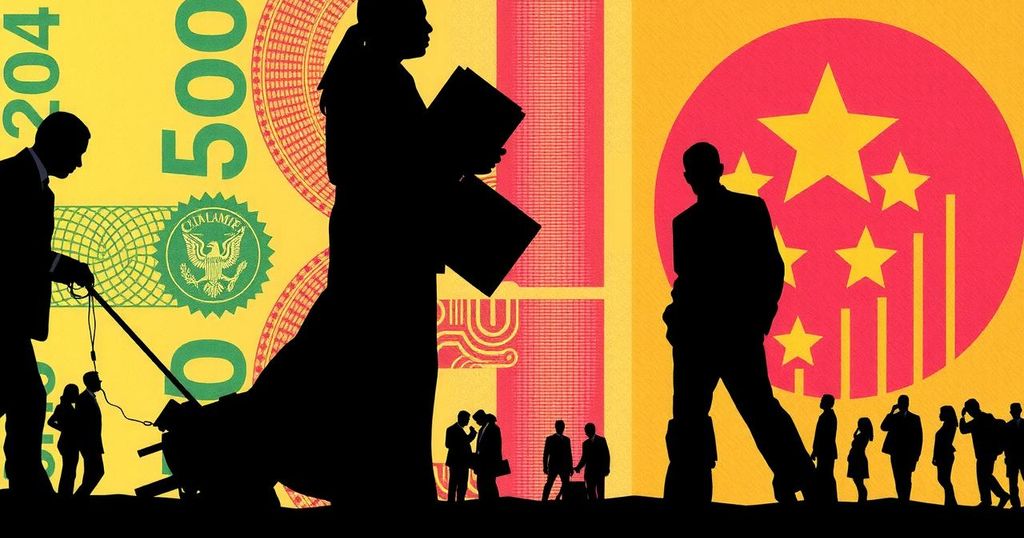Zimbabwe Faces Currency Crisis as New Monetary Policy Unravels

Zimbabwe’s new currency, the Zimbabwe Gold (ZiG), is suffering from a prolonged decline in value against the US dollar, showcasing the challenges faced by Governor John Mushayavanhu amid the country’s historical currency crises. Despite prior optimism about curbing inflation, underlying economic issues, such as increased food imports due to drought and limited foreign investment, are jeopardizing the currency’s stability. The central bank has injected funds into the market and remains hopeful for recovery while addressing these challenges.
Zimbabwe is grappling with significant challenges following the introduction of its new currency, the Zimbabwe Gold (ZiG), just five months ago. Initially launched amid optimism about curbing rampant inflation and stabilizing the exchange rate, the currency has since depreciated against the US dollar for 20 consecutive trading days. Currently, the ZiG commands a value of 26 per dollar on the parallel market, representing a troubling 50% reduction in value compared to the official exchange rate. Governor John Mushayavanhu, now facing the repercussions of this market turbulence, is reminded of the historic currency crises experienced by his predecessors. Underlying economic issues are contributing to this crisis. Economists like Lyle Begbie from Oxford Economics emphasize that without addressing the root causes affecting the ZiG, such as adverse current account and fiscal conditions exacerbated by increased food importation due to a drought caused by El Niño, the new currency’s chances of success are limited. Moreover, lower commodity prices have led to diminished dollar inflows into Zimbabwe, compounded by a lack of access to international capital markets. Hasnain Malik, an emerging market equity strategist, notes that “without sufficient foreign reserves, export growth, or sustained capital inflow the creation of a new currency does not simply magic up stability.” Furthermore, there is a prevailing skepticism about the credibility of Zimbabwe’s central bank, which must work to restore public confidence after a history of ineffective monetary strategies. Despite the grim outlook, Governor Mushayavanhu maintains a cautious optimism, labeling the current turmoil as a “temporary shock”. In a recent statement, he attributed the currency struggles to mismatches in supply and demand, stemming from discrepancies in foreign exchange inflows and outflows. The central bank has swiftly injected $64 million into the currency market this month and is considering additional measures, including tightening monetary policy and utilizing the country’s reserves to stabilize the economy. The Bankers Association of Zimbabwe is collaborating with the central bank to improve currency supply in interbank markets to efficiently satisfy verified invoices, with President Lawrence Nyazema asserting that the recent financial support aims to ensure the availability of goods and services in ZiG at reasonable prices, ultimately fostering confidence in the currency. The central bank is anticipated to announce its latest rate decision imminently, which will further shape the monetary landscape in Zimbabwe as stakeholders continue to navigate this challenging economic environment.
Historically, Zimbabwe has faced several severe currency crises, largely marked by hyperinflation and significant currency devaluation. Following the collapse of the previous Zimbabwean dollar, the introduction of the ZiG was seen as a potential solution to stabilize the economy and restore public trust in the monetary system. However, economic challenges such as reliance on food imports due to adverse weather conditions, fluctuating commodity prices, and limited foreign investment have stifled its effectiveness. The challenges facing the current central bank leadership highlight the complexities of managing a resilient currency in a politically and economically unstable environment.
In conclusion, Zimbabwe’s new currency, the ZiG, is currently facing a stark challenge with a continuous depreciation against the US dollar, raising concerns about its stability and the efficacy of the central bank’s strategies. The underlying economic pressures, combined with historical skepticism towards the monetary authority, complicate efforts to restore confidence. Nevertheless, initiatives such as the central bank’s financial interventions and cooperation with banking associations exhibit a commitment to addressing the pressing economic situation in hopes of fostering a more stable financial future.
Original Source: www.bnnbloomberg.ca








